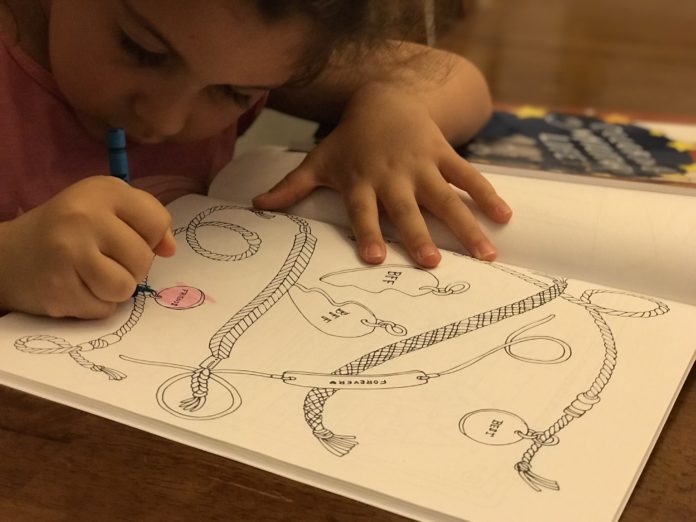Military childhood can be colorful and exciting. It has challenges, but also many rewards: growing up in different states and countries, experiencing a wide range of cultures at home and abroad, being part of a close-knit community, and having friends all over the world.
Jessie Barnes and Christina Rodriguez, adult artists who grew up in different military families, each drew on childhood memories to create a coloring book especially for military families. Christina designed Coloring My Military Life–Book 1, for young artists. Jessie designed Coloring My Military Life–Book 2, for teens and adults.
Christina credits her artistic development to her mobile military life as a child. “The variety of ecosystems—both natural and cultural—I was exposed to at a young age were critical to my development as an artist and citizen of the world,” she says.
Jessie agrees. “I’m thankful that life was kind of challenging on the front end, the constant change and what that means and how to look forward,” she says. “All of that has shaped me into the person I am and am continuing to grow into. I felt empowered and encouraged and I think that has made me very confident in who I am.”
Having friends all over the world and living in many places also means saying goodbye to friends with each move. Jessie acknowledges that one of the challenges of her military life was learning to deal with those losses.
Military parents are sometimes concerned about the long-term effects of those goodbyes, the goodbyes of frequent deployments, and other demands placed on their children. Both Jessie and Christina say having a strong sense of support at home guided them. From their grown-up vantage point, they suggest these ways parents can support their military children:
- Do what any parent should do: “Try to be steady and loving and have healthy relationships with their kids,” says Jessie. “That ultimately is what makes military life something that’s a growing experience.” Healthy, confident parents inspire healthy, confident kids.
- Maintain structure: Christina says the routine and structure around her young military life, particularly while living on base, gave her comfort and stability.
- Look forward: “Take a positive outlook and look at military life as an opportunity for new adventure and new friends,” Jessie says, echoing advice that her parents gave her as a child.
- Don’t feel sorry for your military kids: Parents do sometimes feel a sense of responsibility for the pain military life brings into the lives of their children, whether through moves or deployment. “In every life there’s some kind of pain,” says Jessie. “Military life is no different.” If you feel sorry for your kids, they’ll feel sorry for themselves.
- Show your kids you are confident in their abilities and resilience: “My parents trusted us to be resilient, to rely on and look out for each other,” Christina says. “My siblings and I are close in age, so as long as we had each other, our parents, our dog, and our carefully-curated favorite possessions—for me, art supplies and books—we were gonna be okay.”
Working toward having a healthy military family does more than get kids through the next deployment, or the next move.
“You’re not just preparing kids for military life but for life in general,” Jessie says. “You’re learning from the hard stuff, too. You’re able to see the excitement of what’s to come.”
The two volumes of Coloring My Military Life work together to reflect military experiences, with each artist approaching her designs from a different perspective, based on military childhood and beyond.
Inspired by a childhood pet, Christina used a canine character to convey important events of military life in the book she created. When she was growing up, her family’s dog, Lucinda, was particularly fond of her father and missed him when he was away on temporary duty, Christina says.
“When my dad would call home, we’d make sure to pass the phone to Lucinda as well, so they could ‘talk.’ She would be visibly happier after hearing his voice. One time she went to grab her favorite ball afterwards and played quietly by herself, tail wagging.” she remembers.
“I tried to imbue a sense of curiosity and wonder in certain illustrations in Coloring My Military Life, through the playfulness, expressions, and antics of the dog,” says Christina.
Jessie says every page of the coloring book she illustrated reflects her military childhood and the way it shaped her. She wants readers and colorists to see the value of processing the hard parts of military life while looking forward to new experiences.
“It’s not ignoring that the little boy misses his friends from his last school, or he’s looking forward to having friends at this this new school. It’s not … taking off all the friendship bracelets,” she says, referring to specific illustrations. “It’s remembering those things, but then it’s looking out the plane window at all the grandeur of the new city underneath you and being like, ‘Okay, what’s going to happen here?’ says Jessie.
“Military life has definitely enriched me in every way shape and form; because that’s been my life.”
Christina Rodriguez is the illustrator of Coloring My Military Life–Book 1 and The Wishing Tree by Mary Redman, and the activities in My Dad’s Deployment and My Mom’s Deployment. Jessie Barnes is the illustrator of Coloring My Military Life–Book 2.
Listen to an excerpt from the interview with Jessie, including her responses to the question: Did you put pieces of your military life into Coloring My Military Life?


